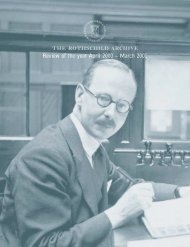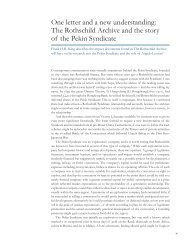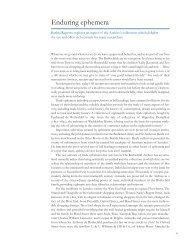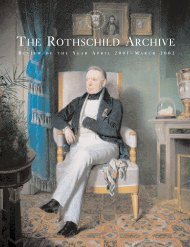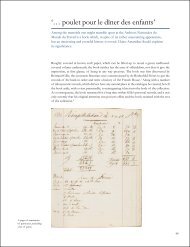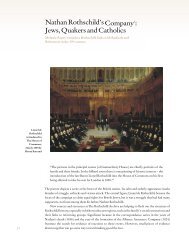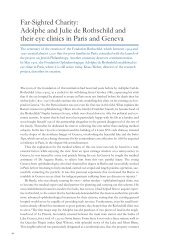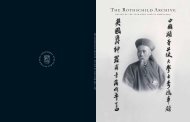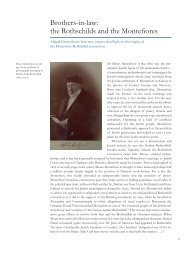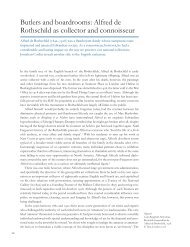66900 Rothschild Archive - The Rothschild Archive.
66900 Rothschild Archive - The Rothschild Archive.
66900 Rothschild Archive - The Rothschild Archive.
You also want an ePaper? Increase the reach of your titles
YUMPU automatically turns print PDFs into web optimized ePapers that Google loves.
On 6 March 1907, Arthur J. Fraser of Parr’s Bank, A.M. Townsend of HSBC, T.S. Nishimaki<br />
of the Yokohama Specie Bank, lawyer Albert Bright for the London <strong>Rothschild</strong>s, F. Heinrich<br />
for the Paris <strong>Rothschild</strong>s, and Takahashi for the Japanese government signed an agreement to<br />
issue £23 million of treasury bonds, half in London and half in Paris, at five percent, with an<br />
issuing price of 99½ pounds – almost parity – and unlike the wartime loans, without security.<br />
<strong>The</strong> usual consortium plus the <strong>Rothschild</strong>s issued the £11,500,000 million in London; the Paris<br />
<strong>Rothschild</strong>s underwrote the entire Paris issue; New York was left out entirely. Since the banks<br />
had issued the 1904 bonds at six percent and at selling prices of 93½ and 90½, the savings were<br />
enormous. Toshio Suzuki estimates that the Japanese government reduced its interest payments<br />
alone by £220,000 (over two million yen) per year through this bond issuance. ₁ ²<br />
On 7 May, Lord <strong>Rothschild</strong> wrote to Paris that, ‘We can heartily congratulate you upon the<br />
expected satisfactory conclusion of a Franco-Japanese arrangement. We have always had great<br />
faith in Japan, faith in their military and naval prowess which the late war amply justified, faith<br />
in the resources of their country and still greater faith in the wisdom of the Japanese rulers …’ ₁ ³<br />
Although Lord <strong>Rothschild</strong> and Alfred had met Takahashi when he first arrived in London in<br />
the spring of 1904, the ‘always’ had not begun until November 1905, that is, after the peace,<br />
when the risk of lending to Japan had been greatly reduced. Takahashi returned to Japan on 10<br />
May 1907, in triumph. On 23 March, before he left London, the government in Tokyo dubbed<br />
him Baron Takahashi. In 1919, during his second term as finance minister, he became a viscount,<br />
before resigning his peerage to run for the lower house of parliament during Japan’s<br />
democratising interlude in the 1920s.<br />
Richard Smethurst is professor of Japanese history at the University of Pittsburgh. He has written and<br />
delivered talks on Takahashi in Japan, Hong Kong, Europe, Great Britain, and North America. His<br />
biography of Takahashi, Takahashi Korekiyo: From Foot Soldier to Keynesian Finance Minister,<br />
will appear in Harvard University’s Asia Center series in 2007. Essays onTakahashi also appear in books<br />
published by the Cambridge University Press, I.B. Tauris, and the Japan Library in Great Britain, and in<br />
the occasional paper series of the Suntory Centre at the London School of Economics.<br />
notes<br />
1 Gotō Shin’ichi, Takahashi Korekiyo – Nihon<br />
no Keinzu (Takahashi Korekiyo – Japan’s<br />
Keynes) (Tokyo: Nihon keizai shinbunsha,<br />
1977).<br />
2 See Smethurst, ‘<strong>The</strong> self-taught bureaucrat:<br />
Takahashi Korekiyo and economic policy<br />
during the Great Depression’, in Learning in<br />
Likely Places: Varieties of Apprenticeship in<br />
Japan, ed. John Singleton (Cambridge:<br />
Cambridge University Press, 1998),<br />
pp.226–38; ‘Takahashi Korekiyo’s fiscal<br />
policy and the rise of militarism in Japan<br />
during the Great Depression’, in Turning<br />
Points in Japanese History, ed. Bert Edström<br />
(Richmond VA: Japan Library, 2002),<br />
pp.163–79; ‘Takahashi Korekiyo’s<br />
economic policies in the Great Depression<br />
and their Meiji roots’, in Politics and the<br />
Economy in Pre-war Japan (London: Suntory<br />
Centre, London School of Economics and<br />
Political Science, 2000), pp.1–24; and<br />
Takahashi Korekiyo: From Foot Soldier to<br />
Keynesian Finance Minister (Cambridge, MA:<br />
Harvard University Asia Studies Center,<br />
2007).<br />
3 ‘Takahashi Korekiyo and Japan’s Victory in<br />
the Russo-Japanese War, 1904–5’, in Britain<br />
and Japan in the Twentieth Century: One<br />
Hundred Years of Trade and Prejudice, eds.<br />
Philip Towle and Nobuko Margaret<br />
Kosuge (London: I.B. Tauris, 2007).<br />
4 Diary (12 April, 13 April). Although<br />
Takahashi took great care in writing letters<br />
in English (cf. his extensive<br />
correspondence with Jacob Schiff between<br />
1906 and 1920), the diary was written for<br />
his personal use only and is replete with<br />
abbreviations, misspellings, and solecisms.<br />
I have left his words unchanged.<br />
5 Diary (22 April, 3 May).<br />
6 Diary (26 October).<br />
7 Takahashi Korekiyo, Takahashi Korekiyo<br />
jiden (Autobiography of Takahashi<br />
Korekiyo) (Tokyo: Chûô kôron 1976),<br />
p.277.<br />
8 ral 000/401, November 1905.<br />
9 ral 000/401, November 1905.<br />
10 For trust in Takahashi and Japan, see ral<br />
xi/130a/0, letters of 25, 26, 29 January<br />
and 12 February 1906; for the ‘devoted<br />
head’ letter, see xi/130a/0/, letter of<br />
7 May 1906.<br />
11 ral xi/130a/0/, letter of 8 May 1906;<br />
xi/130a/1/, letters of 18, 25, 26, 28<br />
February and 1, 7 and 8 March 1907.<br />
12 <strong>The</strong> agreement, Imperial Ordinance No.23<br />
approving the loan, and instructions from<br />
the Finance Minister in Tokyo to<br />
Takahashi and Ambassador Komura in<br />
London, can be found in ral 000/401,<br />
March 1907; Toshio Suzuki, Japanese<br />
Government Loans on the London Capital<br />
Market, 1870–1913 (London: Athlone Press,<br />
1994), pp.134–136.<br />
13 ral xi/130a/1/, letter of 7 May 1907.<br />
25



